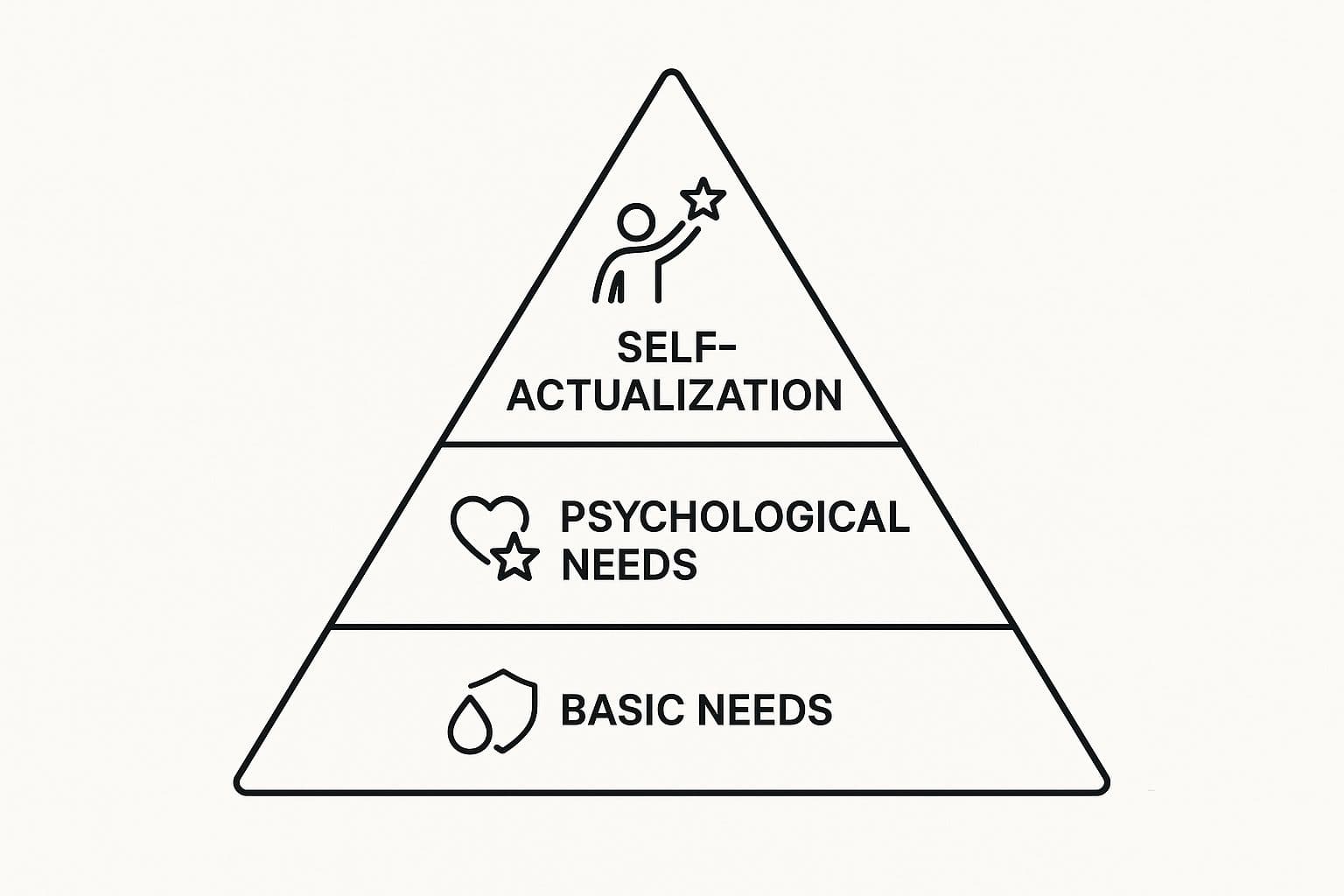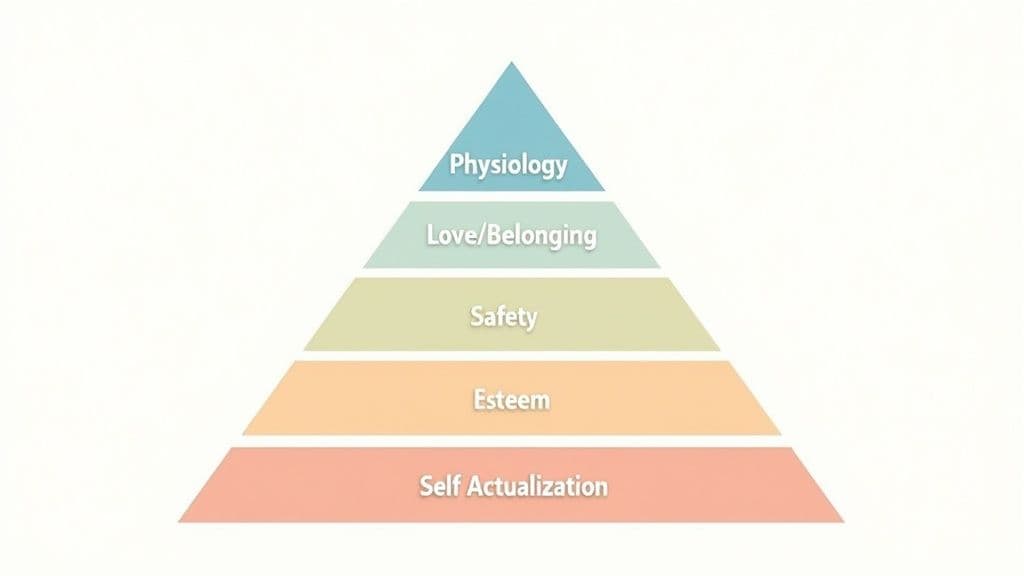So, what exactly is self-actualization? Think of it as the ongoing journey to become the best version of yourself—not chasing perfection, but realizing your unique talents and living a life that feels deeply yours. This article explains Maslow’s model, core traits, and practical steps to find purpose and live more authentically.
September 17, 2025 (2mo ago) — last updated December 4, 2025 (9d ago)
Self-Actualization: Reach Your Full Potential
Understand self-actualization, Maslow’s model, core traits, and practical steps—plus tools and exercises to find purpose and live more authentically.
← Back to blog
Self-Actualization: Reach Your Full Potential
Discover what self-actualization is, inspired by Maslow. Learn core traits and practical steps to grow, find purpose, and live more authentically.
Introduction
So, what exactly is self-actualization? Think of it as the ongoing journey to become the best version of yourself — not chasing perfection, but realizing your unique talents and living a life that feels deeply yours. This article explains Maslow’s model, key traits of self-actualized people, and concrete steps and tools you can use to find purpose and live more authentically.
What Is Self-Actualization?
Picture a tiny acorn. Buried inside is the complete blueprint for a massive oak tree. Self-actualization is the process of giving that acorn the right conditions — soil, water, sunlight — so it grows into its full potential.
This idea sits at the very peak of Abraham Maslow’s Hierarchy of Needs1. It becomes a dominant drive once more basic needs like safety, belonging, and esteem are reasonably met.
The Journey, Not the Destination
Self-actualization isn’t a finish line. It’s an ongoing process of growth and self-discovery. A crucial first step is building a strong sense of self-awareness so you can understand who you are at your core. For practical guidance, see our guide on how to develop self awareness.
Maslow’s pyramid is a useful visual: a stable foundation of physical and psychological needs supports the pursuit of higher fulfillment.

Self-actualization is not an abstract ideal but the natural peak of human motivation built on well-being.
Core Pillars of Self-Actualization
To make this practical, here are essential ingredients for a fulfilled life:
| Pillar | What it means |
|---|---|
| Authenticity | Being genuinely yourself, without wearing a mask for others. |
| Purpose | Having a clear sense of why you’re here and what drives you. |
| Growth Mindset | Believing you can learn, improve, and overcome challenges. |
| Acceptance | Embracing yourself, others, and reality as they are. |
| Peak Experiences | Moments of deep joy, awe, and connection that feel transformative. |
| Autonomy | Making choices that align with your values rather than following pressure. |
These pillars work together to guide you toward a meaningful, creative life.
The Origins of the Self-Actualization Concept

The concept traces back to neurologist Kurt Goldstein, who used the term to describe a universal drive for organisms to realize their potential2. Abraham Maslow later popularized the idea in psychology, placing self-actualization at the top of his Hierarchy of Needs in 19431.
Maslow and the Hierarchy of Needs
Maslow’s model uses a pyramid to show how basic needs—food, safety—form a foundation for psychological needs like belonging and esteem, enabling the pursuit of self-actualization when those needs are reasonably met.
“For Maslow, self-actualization represented the ‘desire to become more and more what one is, to become everything that one is capable of becoming.’”
Maslow’s framework made self-actualization a practical map for personal growth.
Key Characteristics of a Self-Actualized Person

What does self-actualization look like in daily life? Maslow described several traits common to self-actualized people:
- Clear and accurate perception of reality. They see things as they are without being clouded by fear or wishful thinking.
- Profound acceptance of themselves, others, and nature. They can acknowledge flaws without shame.
- Spontaneity and inner-directedness. Actions feel natural because they follow an internal code.
- A continued freshness of appreciation for ordinary experiences—wonder, gratitude, and awe.
- Mission-driven focus. They often channel energy into causes, creativity, or service beyond themselves.
Emotional intelligence supports these qualities; learning how to build emotional intelligence can help you develop stronger self-awareness and acceptance. See our guide on how to build emotional intelligence.
Modern research also highlights the role of autonomy in well-being: Self-Determination Theory links autonomy to intrinsic motivation and psychological health3.
Self-Actualization in History
Real-world examples show self-actualization isn’t reserved for the privileged. Leaders like Frederick Douglass, W.E.B. Du Bois, and Booker T. Washington transformed adversity into purpose and social contribution. Their lives illustrate how resilience and mission can foster profound growth.
Frederick Douglass taught himself to read while enslaved, escaped to freedom, and became an influential voice for abolition—using hardship as fuel for purpose.
How to Begin Your Journey Toward Self-Actualization

The journey starts with small, consistent actions:
- Cultivate self-awareness. Observe thoughts, feelings, and behaviors without judgment. Practices like meditation and journaling help.
- Embrace authenticity. Ask, “Is this decision true to me?” Align actions with values.
- Adopt a growth mindset. Treat challenges as opportunities to learn.
A practical tool for clarifying purpose is Dan Millman’s framework from The Life You Were Born to Live. The Life Purpose App uses your birth date to identify strengths and challenges and offers a structured path toward purpose-driven living4.
Journaling prompts and personal-development retreats can also accelerate insight. See our self-discovery journal prompts for ideas.
By combining self-awareness, authenticity, and a growth mindset, you build a strong foundation for long-term growth.
Clearing Up Common Questions About Self-Actualization
Self-actualization is often misunderstood. Here are answers to frequent concerns.
Is self-actualization a final destination?
No. It’s an ongoing process of unfolding your potential. There will always be new ways to grow and express yourself.
Can I work on self-actualization if my basic needs aren’t fully met?
Yes. While stability helps, growth and adversity often occur together. You can cultivate self-actualizing qualities—like creativity and meaning—even amid challenges. Research also links a sense of purpose to better physical and mental health outcomes, making purpose work valuable at many life stages5.
Do I need to be famous or extraordinary to be self-actualized?
No. Self-actualization is measured by your internal sense of authenticity and purpose, not external recognition. A teacher, carpenter, or parent can be as self-actualized as a high-profile leader.
Quick Q&A — Common User Questions
Q: What is self-actualization in one sentence?
A: Self-actualization is the ongoing process of realizing your unique potential and living a life aligned with your values and purpose.
Q: What are the first steps I can take today?
A: Start with self-awareness (meditation or journaling), clarify your values, and take one small action that reflects those values.
Q: How do I know I’m making progress?
A: Look for deeper satisfaction, clearer values-driven choices, closer relationships, and moments of flow or awe.
Discover Your Life Purpose Today!
Unlock your true potential and find your life’s purpose.
